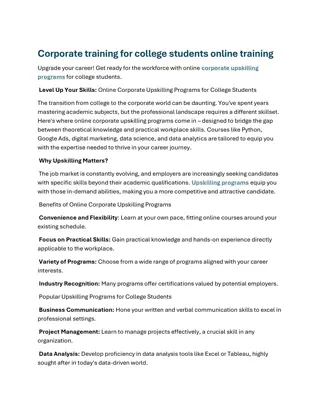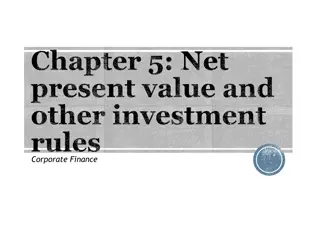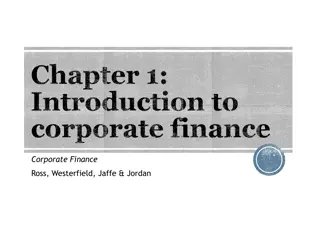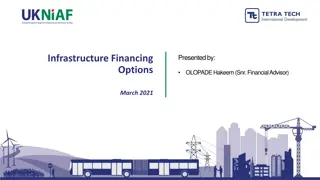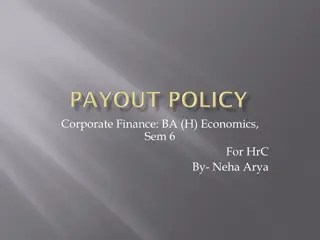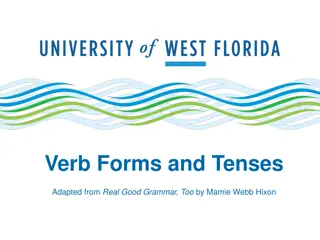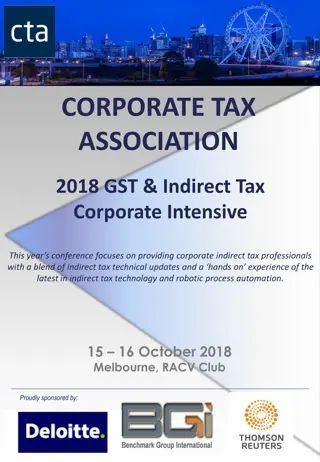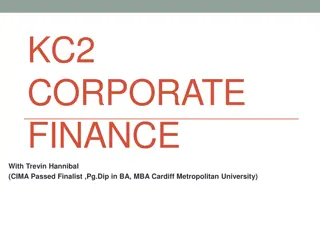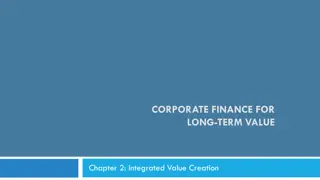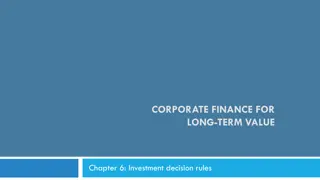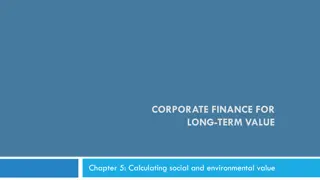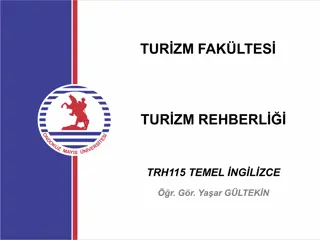Understanding Present and Future Value in Corporate Finance
Explore the principles of corporate finance through key concepts like present value, future value, and interest rates. Learn how to calculate the worth of money over time and make informed investment decisions based on these fundamental financial principles.
Download Presentation

Please find below an Image/Link to download the presentation.
The content on the website is provided AS IS for your information and personal use only. It may not be sold, licensed, or shared on other websites without obtaining consent from the author. Download presentation by click this link. If you encounter any issues during the download, it is possible that the publisher has removed the file from their server.
E N D
Presentation Transcript
European Economy PRINCIPLES OF CORPORATE FINANCE AUDREY DE DOMINICIS adedominicis@unite.it
The most basic principle in finance a dollar today is worth more than a dollar tomorrow
PRESENT VALUE AND FUTURE VALUE Present Value Future Value Amount to which an investment will grow after earning interest Value today of a future cash flow.
The Interest rate We call it r The interest rate is our time machine .
FUTURE VALUE Future Value (FV) FV = PV*(1+r)?
FUTURE VALUE Example FV What is the future value of $100 if the interest is compounded annually at a rate of 7% for two years? FV= 100 * (1+0.07)2 Or FV= 100 * (1+0.07)*(1+0.07)= 114.49
FUTURE VALUE What is the future value of $1,522 if the interest is compounded annually at a rate of 7.5% for five years? FV = 1,522*(1 + 0.075)5= 2,185.028
FUTURE VALUE If you invest $100 at an interest rate of 15%, how much will you have at the end of eight years? Ct= PV (1 + r)t C8= $100 1.158 C8= $305.90
PRESENT VALUE Present value = PV 1 (1+?)? FV PV = Discount Factor (DF)
PRESENT VALUE What is the present value of $114.49 if the interest is compounded annually at a rate of 7% for two years? PV= 1 (1+0.07)2 114.49 PV=100
PRESENT VALUE If the cost of capital is 9%, what is the PV of $374 paid in year 9? PV = FV / (1 + r)t PV = $374 / 1.099 PV = $172.20
PRESENT VALUE If the PV of $139 is $125, what is the discount factor? PV = FV / DFt DFt= PV/ FV DFt= $125 / $139 DFt=0.899 WE START FROM THIS FORMULA Attention! It is not the r but the Discount Factor (DF)!
PRESENT VALUE If the PV of $139 is $125, what is the interest rate? PV = FV/(1+r)? (1+r)?= FV/ PV (1+r)?= $139 / $125 r=1.112 1= 0.112=11.2% WE START FROM THIS FORMULA
PRESENT VALUE The cost of a new automobile is $10,000. If the interest rate is 5%, how much would you have to set aside now to provide this sum in five years? PV = FV / (1 + r)t PV = $10,000 / 1.055 PV = $7,835.26
SUMMARY FV = PV (1+r)? Future Value ?? ?? ??= ?? (1+r)?= so ?? - 1 ?? Present Value PV = (1+?)? 1 Another way to write the PV formula, useful to understand the Discount Factor PV = (1+?)? FV PV= DF FV so Discount Factor DF = ?? ??
SUMMARY FV = PV (1+r)? ?? 1 PV = PV = (1+?)? FV or (1+?)? DF = ?? 1 REMEMBER! DF= (1+?)? ?? ??= ?? ?? - 1
THE NET PRESENT VALUE (NPV) Suppose you own a small company The construction of an office block that is contemplating
THE NET PRESENT VALUE (NPV) Cost of buying the land and constructing the building is 700,000. PV Your real-estate adviser forecasts a shortage of office space and predicts that you will be able to sell it next year for 800,000 (assume it as true). FV In order to have r, we apply the formula (1+r)?= FV/ PV so we will have r = 800,000/700,000 1 = 1.143 -1= 0.143 = 14.3% YOUR COMPANY CAN CHOOSE! We need a term of comparison! What is the term of comparison for shareholders to know if this project is good or not?
THE NET PRESENT VALUE (NPV) Shareholders can: First kind of investment: earn a 7% profit by investing for one year in safe assets (e.g. Treasury bond securities); Second kind of investment: Invest in the stock market, which is risky but offers an avarege return of 15%. But for our project what is the term of comparison? In a nutshell: WHAT IS THE OPPORTUNITY COST OF CAPITAL? (7% or 15%?) The answer is 7%: that s the rate of return that your company s shareholder could get by investing on their own at the same level of risk as the proposed project! Remember, we are assuming, for the time being, that the FV of the office block is known with certainty. So, the level here is of 0 risk.
THE NET PRESENT VALUE (NPV) We know that the opportunity cost of capital is 7%. We can compare this opportunity cost of capital with the return of our project, which is 14.3%. 14.3% > 7% Our project Treasury bonds
THE NET PRESENT VALUE (NPV) Valuing an Office Building Step 1: Forecast cash flows Cost of building = PV = C0= 700,000 Sale price in Year 1 = FV =C1= 800,000 Step 2: Estimate opportunity cost of capital If equally risky investments in the capital market offer a return of 7%, then Cost of capital = r = 7%
NPV (Valuing an Office Building) Step 3: Discount future cash flows C = = = 800 , 000 PV 747 664 , 1 In order to have next year 800,000 (the same FV of our project) with Treasury bonds, we have to invest 747,664.(more than our project)! In a nutshell: investing in Treasury Bonds is more expensive than our project! +r + 1 ( ) 1 ( 07 . ) Step 4: Go ahead if PV of payoff exceeds investment = NPV 747 664 , 700 000 , = 47 664 ,
NPV (NET PRESENT VALUE) ?1 NPV = ?0+ (1+?) ?0< 0 Because we payed 700,000 so it is 700,000
NPV (NET PRESENT VALUE) NPV= -700,000 + 800,000 1.07 = 47,664
NPV (NET PRESENT VALUE) Use the original example. Should we accept the project given a 10% expected return? 800,000 = NPV = -700,000 + 27 $ , 273 1.10
PERPETUITIES & ANNUITIES Perpetuity - Financial concept in which a cash flow is theoretically received forever. (e.g. British Consol) PV= ? ?
PERPETUITY We can have the first payment of perpetuity: Immediately After x years
PERPETUITY PERPETUITY (first payment in year 1) FV PV PV = ? ?
PERPETUITIES & ANNUITIES Example What is the present value of $1 billion every year, for all eternity, if you estimate the perpetual discount rate to be 10%? = = $1 bil PV billion 10 $ . 0 10
PERPETUITIES & ANNUITIES An investment costs $1,548 and pays $138 in perpetuity. If the interest rate is 9%, what is the NPV? NPV = investment +C / r NPV = $1,548 +138 / .09 NPV = $14.67
PERPETUITY PERPETUITY (first payment in year t) (Ex: We have a perpetuity of 100 which starts at year 4. What is the PV of this perpetuity if the interest rate is 4%?) FV 100 100 100 100 100 100 100 100 100 PV ? ? 1 (1 + ?)? PV = ? 1 ? * 100 0.04* (1+?)? 1 ?? = (1+0.04)4 = 2137,01
PERPETUITY If we want to know the PV of a perpertuity which doesn t start immediatly we have to compute this formula: PV = ? 1 ? * (1+?)? Remember! t is the number of missing years
PERPETUITIES & ANNUITIES Example - continued What if the perpetuity of 1 bil does not start making money for 3 years with an interest rate of 10%? ( PV 3 1.10 10 . 0 ) = = $1 bil billion 51 . 7 $ 1 Perpetuity We have to discount the perpetuity because during the first 3 years this asset doesn t make money
PERPETUITIES & ANNUITIES Annuity - An asset that pays a fixed sum each year for a specified number of years
ANNUITY ANNUITY The state lottery advertises a jackpot prize of $70,000, paid in 8 installments over 8 years of $ 9,500 per year, at the end of each year. If interest rates are 3.7% what is the true value of the lottery prize? FV 9,500 9,500 9,500 9,500 9,500 9,500 9,500 9,500 PV PV = = 9,500 0.037 -9,500 1 0.037 * (1+0.037)8 = 64,760.911 ? ? * 1 PV = ? ? - (1+?)?
PERPETUITIES & ANNUITIES Annuity - An asset that pays a fixed sum each year for a specified number of years 1 C C PV = + t 1 ( ) r r r
PERPETUITIES & ANNUITIES PERPETUITY: ? ? It starts immediately ? ? * 1 It starts after t years (1+?)? ANNUITY: ? ? -? 1 ? * (1+?)?





